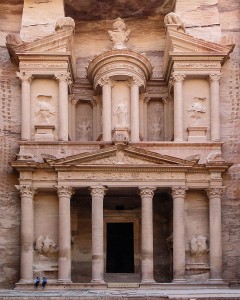
Archaeological site of Petra is astronomically aligned, as part of astral religion
N. B.
- 3
 This fabulous site of Petra in Jordan was occupied during the era when Christianity began to be formulated. Contrary to the falsehood that Christianity has nothing to do with astral religion or astrotheology, the religion most assuredly is part of this same millennia-old tradition. Claims otherwise are ignorant and unscientific.
This fabulous site of Petra in Jordan was occupied during the era when Christianity began to be formulated. Contrary to the falsehood that Christianity has nothing to do with astral religion or astrotheology, the religion most assuredly is part of this same millennia-old tradition. Claims otherwise are ignorant and unscientific.
Note also that the “Nifty Nabateans” were both wine merchants and eventual teetotalers, influencing the subsequent Islamic prohibition of alcohol. The god Dushara or Dusares, mentioned in the article below, is the Arab version of Dionysus/Bacchus, the Greek wine god. Typically in antiquity, the popular wine god was also considered to be solar, as the sun was seen to bring the rains, ripen the planet and fruit, and ferment the juice.
The movement of the Sun in the skies of Petra determined the way in which the monuments of this and other Natabean cities were erected….
The results, published by the ‘Nexus Network Journal’, indicate that those great buildings were erected bearing in mind the equinoxes, solstices and other astronomical events that determined the Nabataean religion. The Nabataeans prospered in the first century BC and the first century AD in what is now Jordan and neighbouring countries.
“The Nabataean monuments are marvellous laboratories where landscape features and the events of the sun, moon and other stars interact…
“The astronomical orientations were often part of an elaborate plan…and, possibly, a mark of the astral nature of their religion, which showed incredible ‘hierophanies’ or demonstrations of the sacred on monuments related to cultic times and worship”.
A clear example is seen in Ad Deir, the Monastery at Petra. During the winter solstice, the light of the setting sun entering through the gate of the monument illuminates the sacred motab. It is a podium where some stone blocks, which represent divinities such as the god Dushara, are placed.
“The effect is spectacular, and would have only been observable during the few days closest to this solstice,” commented Belmonte, who also emphasises how, just in this moment, another curious phenomenon is produced. As observed from the motab itself, the setting of the sun recreates the aspect of the head of a lion, the animal of the Nabataean goddess Al Uzza, on the opposite rocks.
Mathematical calculations also show the astronomical plan that the Urn Tomb follows, another famous monument where king Malichus II is thought to be buried. Its main gate is centred with its environment according to the equinox sunset, when the day equals the night, and the solar rays during the summer and winter solstices establish the two interior corners of the building.
“This amazing set of three alignments within the plan of the tomb, in combination with significant features in the distant horizon can hardly be ascribed to chance,” underlined Belmonte. “We consider that it is a deliberate attempt to convert the hall of the Urn Tomb into a type of time-keeping device”.
When in 446 AD the Christian Bishop Jason converted the Urn Tomb into the Cathedral of Petra, the solsticial markers also served as a reference in determining Christmas Eve (24 December) and St. John the Baptist (24 June), the date on which the monument was consecrated to the new religion.
Source
How celestial events influenced orientation of the great constructions of the Nabataeans
The results, published by the ‘Nexus Network Journal’, indicate that those great buildings were erected bearing in mind the equinoxes, solstices and other astronomical events that determined the Nabataean religion. The Nabataeans prospered in the first century BC and the first century AD in what is now Jordan and neighbouring countries.
“The Nabataean monuments are marvellous laboratories where landscape features and the events of the sun, moon and other stars interact,”
Read more at: http://phys.org/news/2014-03-celestial-events-great-nabataeans.html#jCp
3 thoughts on “Archaeological site of Petra is astronomically aligned, as part of astral religion”
Comments are closed.


The Nabataean solar god Dhushara, transliterated into Greek as Dusares derives from the Arabic term sha’ir “to know” or “to perceive” (active participle of the verb sha’ara) so that the more accurate title should read Dhu’sh Sha’ara which implies that he is the ‘Lord of the One who Sees or Knows’. Thus Dusares can be better understood as a god of ’seers’ or ‘soothsayers’, and connects him directly to Apollo and not Dionysus or Zeus, particularly when we remember that Apollo is the oracular god of the sun.
Thank you for the interesting information. The fact is, however, that Dusares is the Arab wine god equivalent to Dionysus, who is also a solar deity, as were many other gods and goddesses in antiquity. (See, e.g., Macrobius.) The sun is viewed as the ripener of the grapes and fermenter of the wine, among many other divine roles.
I discuss these ideas in depth in my Moses book, as well as others, including Suns of God: Buddha, Krishna and Christ Unveiled.
Paul, Great minds think alike! I came to exactly the same conclusion re. the etymology and meaning of the name Dusares. The word also connects well with Mt. Arafat near Mecca, otherwise called ‘the Hill of Divination’ from the Arabic root ‘ar-afa’ meaning seer, diviner i.e. one who sees or knows through the mantic arts. The outline of the temple pediment dedicated to the goddess Allat can still be made out using Google earth. And guess what, in keeping with many other temples of Allat it is aligned to the Winter Solstice.